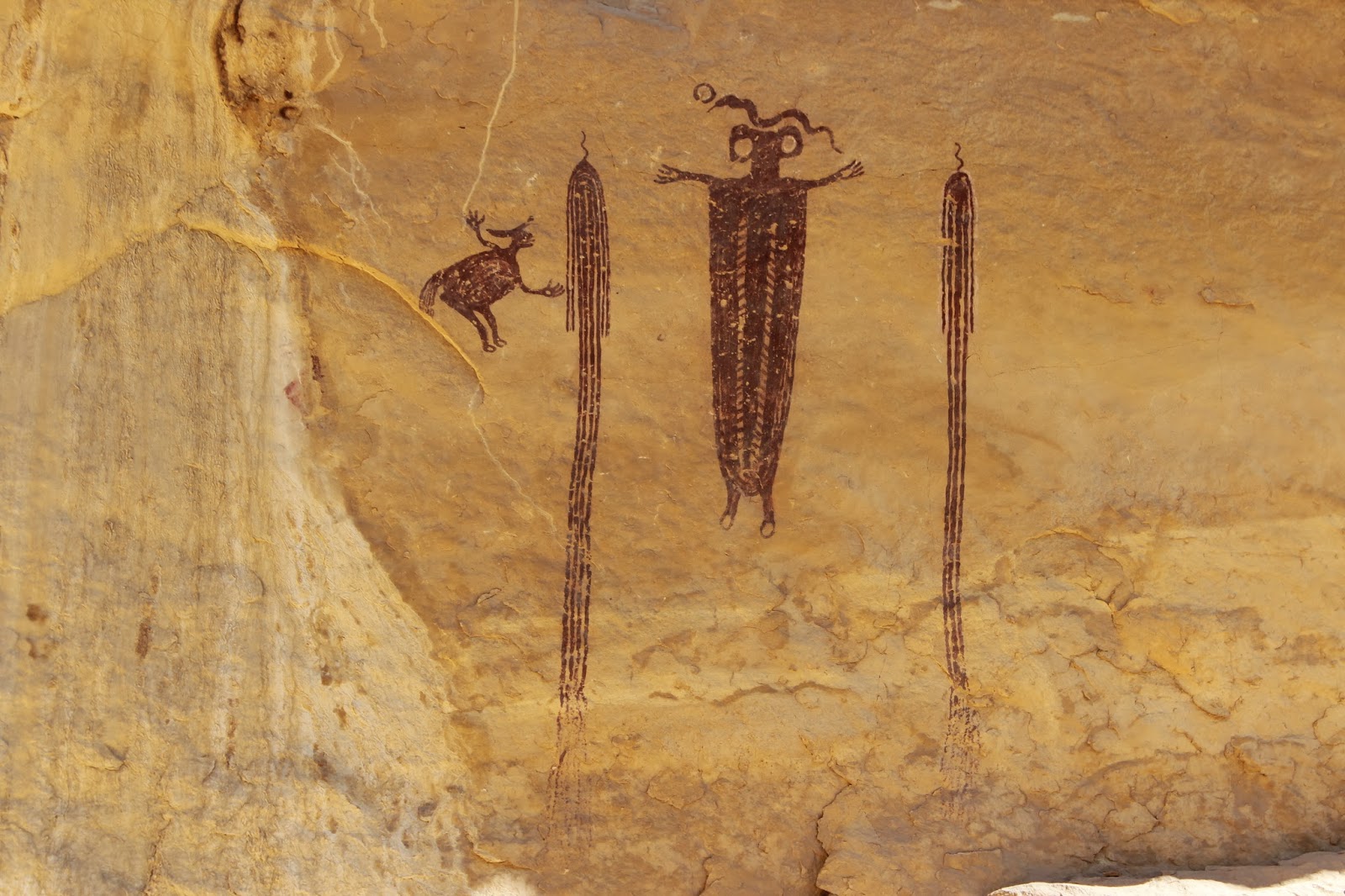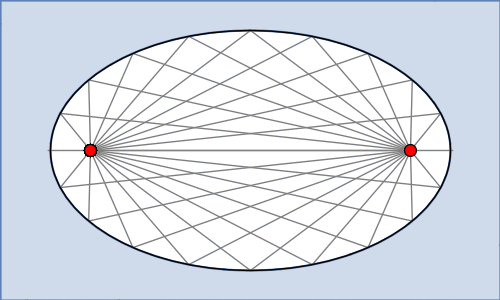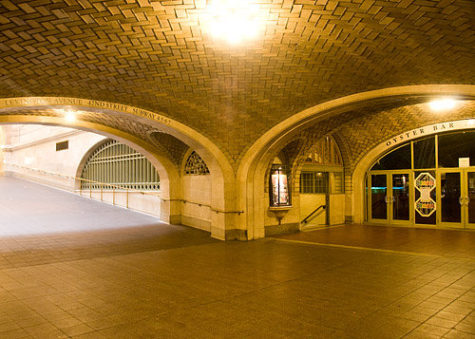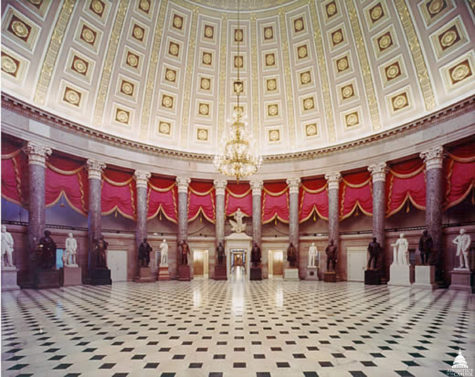 In caves and rock walls of the southern Utah desert, pictographs have been painted, added to the backs of clamshell-shaped sandstone enclosures. Many are noted to have acoustic properties, meaning these ancient, Indigenous images seem to be correlated with the way sound reflects around them. I’ve spoken in a normal voice back and forth from one sheltered rock art panel to another an eighth of a mile downcanyon. The way sound spreads and is refocused, we could hear each other’s every word.
In caves and rock walls of the southern Utah desert, pictographs have been painted, added to the backs of clamshell-shaped sandstone enclosures. Many are noted to have acoustic properties, meaning these ancient, Indigenous images seem to be correlated with the way sound reflects around them. I’ve spoken in a normal voice back and forth from one sheltered rock art panel to another an eighth of a mile downcanyon. The way sound spreads and is refocused, we could hear each other’s every word.
James Farmer, from the Utah Rock Art Research Association, wrote that panels from the ghostly and enigmatic Barrier Creek tradition in Utah (pictured above) contain what he sees as thunderstorm motifs. At one of these Barrier Creek panels, he witnessed a cloudburst with thunder, waterfalls, and falling boulders. He wrote about the intensification of sound from the storm around the rock art, “it seems inconceivable to me that any ancient archaic hunter-gatherers witnessing a similar event would not have been just as astonished as me, and would have naturally invested the location with divine, supernatural powers.”
The nascent field of “archaeoacoustics” studies the way sound and archaeological sites interact. I look at this as not just an ancient feature, but one that we walk through everyday. Cathedrals and capital domes have been noted for the way they capture and amplify sound. By happenstance or not, resonance is part of the way we relate to architecture, whether human made or carved by nature.
Have you ever walked through an airport or the lobby of a building and noticed a sudden change in the acoustics? Even in a crowd, you hear your own footsteps as if you’d walked across a microphone. Like the acoustics of Barrier Creek panels, this is something I’ve explored in modern human environments. A friend who goes looking for them with me calls them “focalizers.”
Once you start looking and listening, you find them all over, outdoor gardens, entrances to skyscrapers. One of the best I’ve found is a dome of focused sound created by the ceiling of Terminal C of the George Bush International Airport, near the turn to Gates 24-27. It’s like stepping through an invisible veil into a secret space. These are architectural simplicities, a circle or cupola pleasing to the eye, maybe with benches or planters or sculptures. The center is often marked with some small feature, a compass star, an intersection of lines, a mosaic of a circle or globe, or simply a drain pipe if not too fancy.
If you happen to pass over that center, or pause in conversation, the effect is immediate. You’ll hear your own voice reflected back on you with startling and encompassing clarity, louder than any other sound in the vicinity.
A related phenomenon is the “whispering wall” or “whispering gallery.” This is where a curved surface carries the slightest vocalization to another, distant location. Grand Central Station in New York has a famous one. On the lower concourse, just outside of the Oyster Bar, the voice of a person standing in one corner will travel up and over the crowd and land on the ears of a person standing in the opposite corner 30 feet away.
The “focalizer” is slightly different, perhaps more ubiquitous. These are places that broadcast yourself back to you. I’ve taken to calling them “whispering wells.”
Circular is best, though a semi-circle will do. Step into the center and say something or make a hiss. Whatever sound you create, even a clearing of your throat if you don’t want to attract attention, will come back from surrounding walls at exactly the same instant, none of the messy humdrum of baffles and angles, no single echo point any closer or father away than the others.
Tell somebody about it, a stranger walking by. I’ve done this, it generally works once they get past their understandable suspicion. Lead them to the center (many of these are in very public and non-threatening locations) and when they speak to ask what they should do, they shut their mouth instantly, then say something else like hello or echo and look back at you amazed. Some people become giddy with excitement. Try the front of the Transamerica Pyramid in San Francisco, not the finest example, but an easy one to find. It just takes a few seconds. Step into the middle of one of its outdoor circles. An acoustic bubble envelopes you. You can hear the traffic and noise around you, but if you start singing quietly, which generally draws only mild attention, you are singing back to yourself, audience of one.
I move through the city the same way I move through the desert, looking for shaded alcoves that might hold rock art, hissing or clucking my tongue to hear the sound bounce back. Buildings become canyons, and the rounded architecture of lobbies, capital domes, or outdoor sitting areas where professionals eat their lunches, become natural shelters, sites of acoustic reflections. And there I stand humming out loud, apparently imbued with supernatural powers.
Photos: Barrier Creek petroglyphs, Utah; Grand Central Station Whispering Wall, NY; US Capital, Washington DC.
I love this essay. I reminds me of the most astonishing acoustic experience of my life. I was traveling in Italy, in Pisa, and happened into the Battistero, whichis very close to the famous Leaning Tower. It was the end of the day and when I and a few tourists entered, the guard at the door closed the door behind us–I thought to keep others from entering. He then took off his hat and belted out a slow arpeggio. Three notes with rests between them. He sang well and so the notes alone were beautiful to hear. But after a few seconds, the three separate notes merged. The arpeggio became a chord. The architecture of the Battistero in cahoots with time did the integration. The guard then sang out another half-dozen arpeggios, to the absolute delight of us lucky tourists. He then opened the door, signaled for us to leave, and we all went our ways floating on our moment of awe. I always have been grateful to that guard. Here is a link that shows the cylindrical-domed structure with acoustic physics to die for: https://it.wikipedia.org/wiki/Battistero_di_San_Giovanni_(Pisa)#/media/File:Pisa_-_Battistero,_esterno_2.JPG
Hi Ivan! I heard that too, and thank you for reminding me. Your description is perfect. Here’s a video/audio: https://www.youtube.com/watch?v=i8aaDlFa1-I
Many years ago, taking a tourist tour of some religious auditorium in Salt Lake City, I noticed that to demonstrate the acoustics the docent had all of us ‘gentiles’ cluster near the center towards the back and had his assistant drop a pen at some point to to the let of front center. I never though much about it until decades later I took the same tour and noted the same arrangement in the acoustics demonstration.
There are unintended acoustics and very amazing intended acoustics to be found, such as the quetzal bird sound that bounces back when you clap in front of the pyramids at Chichen Itza in Yucatan, Mexico. I wonder how many more are to be rediscovered as we clap, chirp, sing and yell at and into the places we visit and live?
Totally agree!
During a dedication ceremony at the base of the Buckhorn Wash pictograph panel a few years ago, I went across the stream to a sloping section of slickrock in the middle of the canyon, facing the panel. I could hear every note, every word! AND, the figures in the panel seemed to be adaptations of the desert varnish streaks on the adjacent cliffs. I was convinced at that moment that this was all a performance stage, created by design with attention to the acoustics and visual surroundings!
Years earlier, I had the “Terminal C” experience in Casa Rinconada at Chaco Canyon. It was open to visitation then and I had a tour group slowly filing in to sit on the bench around the base of the circular structure. As more people came in, I slowly kept stepping backward to keep everyone in view. And then I had the experience Childs describes so well: “If you happen to pass over that center, or pause in conversation, the effect is immediate. You’ll hear your own voice reflected back on you with startling and encompassing clarity, louder than any other sound in the vicinity.” It was sudden and it was so startling I just had to stop! The implications for how that effect was purposely employed in other great kivas is yet to be explored.
Similarly, there is growing evidence that an “amphitheater” was purposely created on the cliff face across the canyon, between Pueblo Bonito and Chetro Ketl.